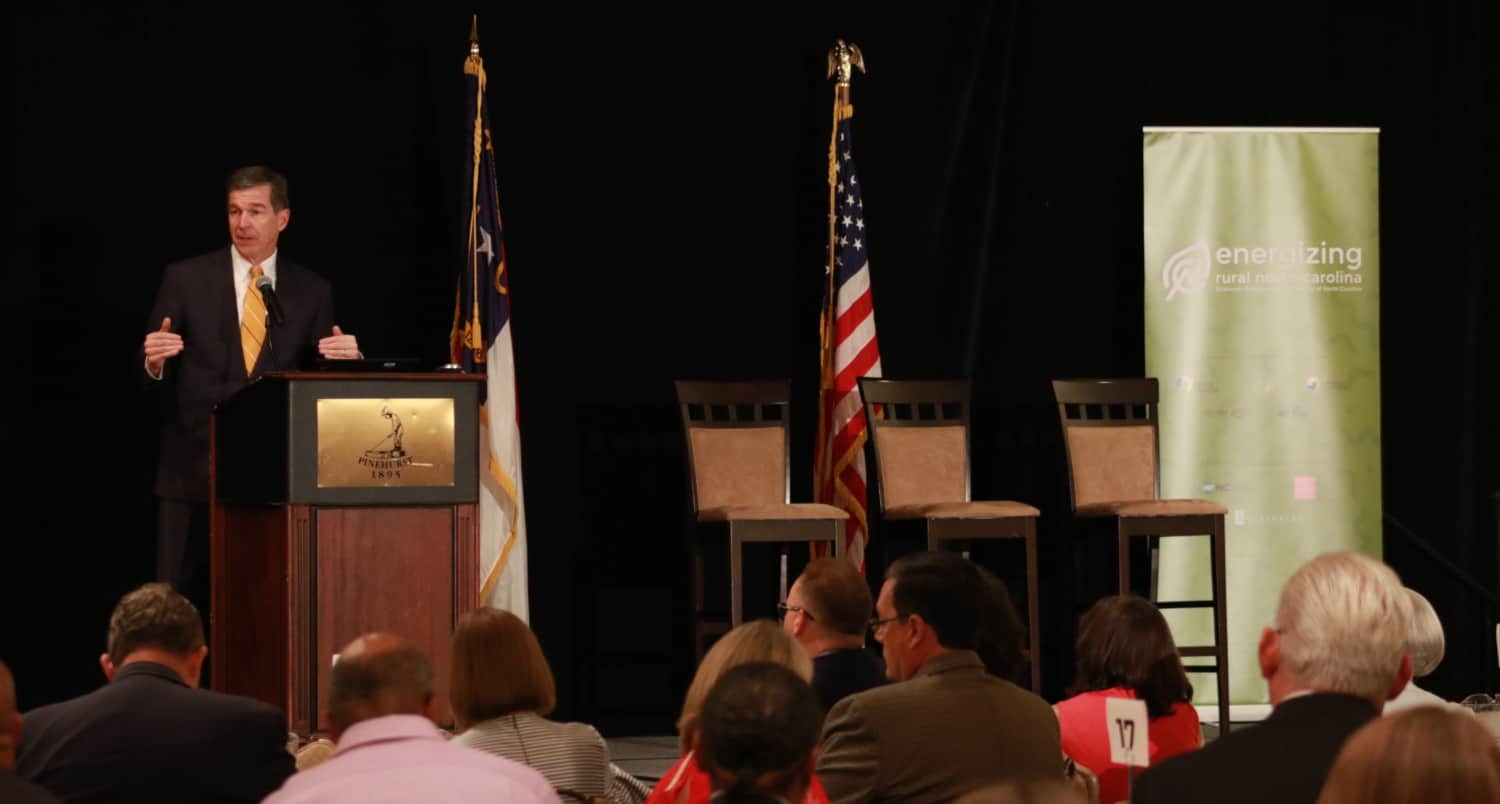The first day of a conference exploring strategies to foster rural economies and communities across the state attracted local economic developers from 65 counties to Pinehurst Thursday. Energizing Rural North Carolina, hosted by the Economic Development Partnership of North Carolina, outlined two of five “building blocks” to structure presentations and discussion: education and workforce.
“We have to solve our own problems,” said Mike Hawkins, Transylvania County Commissioner and EDPNC board member. “Local issues require local solutions.” If you run a rural hospital, transportation is also important to you, Hawkins said. If you are a community college president, you also have to worry about access to pre-K in your region. If you are an economic developer, health care matters to you. These issues, he said, are interconnected and must be tackled that way.
“We all wear a lot of hats when we wake up in the morning and go out into the world and try to make our particular … communities better,” Hawkins said. “And that’s part of what we’re going to be doing here in the next couple of days.”
Here are five takeaways from Thursday afternoon:
- Gov. Cooper showed up to talk about rural issues.
Cooper delivered opening remarks, highlighting the unique qualities of rural North Carolina and areas where rural communities need investment. Raised in Nash County, Cooper said the slow pace, friendly people, open space, and ability to come together as a community in times of need are all rural characteristics “we need to sell, sell, sell.”Cooper spoke on his economic development initiative announced in January, Hometown Strong, which plans to bring state government and local leadership together to identify and attract resources.
“We believe it can play a significant role in making sure that rural North Carolina is heard, and we focus attention on that part of the state, and that we’re successful in economic improvement,” he said.
Cooper said broad issues remain in rural parts of the state like broadband connectivity, health care affordability, disaster recovery, and the gap between available jobs and workforce skills. He emphasized the education talking points he typically conveys — raising teacher salaries to the national average, improving the “cradle to college” continuum, and becoming one of the top 10 educated states by 2025. He also touched on the community college system’s role in creating economic opportunity, mentioning NC Job Ready, his program centered on postsecondary attainment and workforce readiness.
“Our community colleges are often the backbone of rural development,” Cooper said. He pointed to Catawba Valley Community College, in Hickory, where advanced furniture manufacturers and educators worked together to train students in a furniture academy and place them in good-paying jobs.
“That’s the kind of local innovation we need to encourage.”
- Some say the current educational system needs (a lot of) work.
The block of the conference focused on education — where the current system is and where it should go — was headed by Catherine Truitt, chancellor of the online Western Governors University North Carolina. Truitt, former policy advisor for Gov. Pat McCrory, broke down high school graduation rates, proficiency levels, and teacher attrition in rural communities and statewide.“A question I get a lot as an educator is, ‘Why should we change? Why should our system of education change? I went to public school and I turned out just fine.'”
Truitt predicted a “fourth revolution” driven by artificial intelligence and machine learning that will require unprecedented and ever-changing skillsets from the workforce.
“We need to have an education system that prepares workers and professionals to be able to know what to do when they don’t know what to do,” she said.
Truitt argued the educational system’s “one size fits all” model, designed around a factory mindset, is in need of rethinking through personalization and technology. Truitt showed disparities in reading proficiency for students who are economically disadvantaged: 24 percent of economically disadvantaged third graders in 2017 read proficiently compared to 53 percent of their non-economically disadvantaged classmates. For eighth graders the same year, 20 percent of economically disadvantaged students read proficiently, while 44 percent of non-economically disadvantaged students read proficiently. Seventy percent of students in rural counties are considered economically disadvantaged.
Eighteen percent of North Carolina high school seniors in 2017 met all four ACT college readiness benchmarks, Truitt said. Forty-seven percent met none of the benchmarks.
“Almost half of students in North Carolina meet no ACT college readiness benchmarks, and yet we have the highest graduation rate in state history right now at 86 percent,” Truitt said.
The simultaneous rise in graduation rates and lack of college and career readiness, Truitt said, should cause alarm.
“This calls into question, what does a high school diploma mean?” Truitt said. “What does it tell us that kids can know and do?”
- Collaboration between industry and education can link students with well-paying jobs no one is taking.
One of the most consistent themes through the afternoon was breaking down silos between business and education to better prepare students for jobs in their communities. Nathan Ramsey, director of the Mountain Area Workforce Development Board, led attendees in the discussion around workforce.“The fact is there are many employers in rural North Carolina that have good-paying jobs that they cannot fill,” Ramsey said. He argued some of these problems are also faced by employers in urban parts of the state. Dual enrollment, or high schoolers taking college courses for free, is one way the state has started to encourage postsecondary attainment.
“It’s not about earning a four-year degree,” Ramsey said. “It’s about attaining that postsecondary credential.”
Leaders of the Wilson Academy of Applied Technology (WAAT) explained how they started an early college that bridges industry and education by getting the right people in the room and coming up with mutually-beneficial solutions. When students graduate from high school, they also receive an associate’s degree from Wilson Community College. WAAT Principal Krystal Cox runs an advisory council with 13 business representatives from the area to encourage communication and collaboration.
Jennifer Lantz, executive director of the Wilson Economic Development Council, works to bring resources to the community. She explained there are over a thousand open manufacturing jobs in the county. She said the model can work anywhere if the specific needs of the community are identified.
“I would never suggest that what we’re doing in Wilson, North Carolina, will work anywhere else, but the process we use could work anywhere,” Lantz said.
- Digital learning, when done thoughtfully, can make a difference in achievement.
David Sutton, assistant superintendent in Rutherford County, outlined his countywide one-to-one approach. Each pre-K to 12th grade student takes home a device from school. Sutton said the initiative has made a big difference in student achievement, with the county passing statewide performance measures they used to fall below as recent as 2013.“Our performance exceeds the prediction of our context,” Sutton said, highlighting that poverty normally correlates with low academic performance grades given by the state’s education department. Rutherford County, Sutton showed, has a similar story to many rural parts of the state: one of economic struggles intensified by the Great Recession. The county has a current 4.9 percent unemployment rate compared with the statewide 3.7 percent.
“… Schools are not abstractions,” Sutton said. “The same conditions of poverty and economic need and stress that exist throughout the community also exist within our schools.”
He said learning how to best use technology to teach effectively has improved student outcomes despite the community’s economic challenges. Sutton said county leaders have started by identifying the student outcomes they want, and then worked to use digital learning as a tool to meet those goals.
“Our one-to-one digital learning effort is fully integrated and meaningfully connected to a comprehensive five-year plan for demonstrable improvements in student achievement,” Sutton said. “And if schools are not willing to integrate that effort into a broader framework of thoughtful, purposeful, strategic improvement, then it really isn’t worth doing at all.”
- Investing in early childhood education has long-term benefits.
Henrietta Zalkind, executive director of The Down East Partnership for Children, underscored the importance of establishing a solid foundation for students to learn and succeed later in school and life. The Partnership is a nonprofit organization that supports families in Nash and Edgecombe counties through a variety of programs around parenting, development, health, and education.For 25 years, the organization has provided wraparound services for children and their families in the earliest years of life based on the idea that better experiences early on lead to better outcomes for entire communities.
“We work across race, we work across class, geographic boundaries,” Zalkind said. “For those of you who know about Nash and Edgecombe counties, that was no small feat. They have had a long history of not working together. But we use the data. We have always started with wherever we were, set that target to move forward, and used whatever evidence-based program we thought was a good fit.”
The Partnership has seen a dramatic increase in enrollment in high-quality preschool since its inception. Enrollment in the highest-quality care possible has risen from 6 percent of Edgecombe County children in 1993 to 88 percent in 2017, and from 7 percent of Nash County children in 1993 to 72 percent in 2017. Zalkind said the organization tries to meet families where they are and give them the best combination of resources — like preschool scholarships, parenting guidance, and health services.
“We bundle programs so that you get enough of a dosage over a long enough course of time,” she said
On Friday, the conference went on to explore rural infrastructure, health, and leadership.



